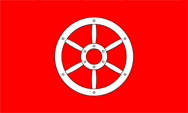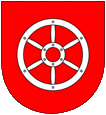Mainz |
|
|
|
| Übersicht – Contents: | |
Diese Seite ist Teil des Projektes
Mainz |
|
|
|
| Übersicht – Contents: | |
Flaggen – Flags: |
|
 |
Flagge des Erzbistums Mainz – flag of the Archbishopric of Mainz, Quelle/Source: World Statesmen, Wikipedia (D) |
 |
Flagge der Stadt Mainz – flag of Mainz City |
|
|
|
Wappen – Coat of Arms: |
|
 |
Wappen des Erzbistums Mainz – coat of arms of the Archbishopric of Mainz, Quelle/Source: Wikipedia (D) |
|
|
|
Bedeutung/Ursprung der Flagge – Meaning/Origin of the Flag: |
|
| Ursprünglich zeigte das Wappen den Patron der Stadt, den Heiligen Martin. Um 1300 wurde der Heilige um ein Rad ergänzt und wenig später nur noch das Rad in Silber auf rotem Untergrund verwendet. Das Rad soll auf Erzbischof Willegis zurückgehen, der damit dem Stolz auf seine einfache Herkunft (sein Vater war Radmacher) Ausdruck verleihen wollte. Die Flagge des Erzbistums war eine Wappenflagge, ein einfarbig rotes Tuch mit einem silbernen Rad in der Mitte. |
Originally the coat of arms showed the patron of the city, the St. Martin.
About 1300 the saint was supplemented by a wheel and a little later they
only used the wheel in silver on a red background. The wheel should go back to Archbishop Willegis, who wanted in this way to express his pride for his simple descent. His father was a wheelwright. The flag of the archbishopric was a scutcheo flag, a plain red flag with a silver wheel in the middle. |
| Als sich Stadt und Erzbistum administrativ trennten, übernahm die Stadt Mainz zwei Räder, die mit einem kleinen Kreuz verbunden sind, in ihr eigenes Wappen. | When the city and the archdiocese separated administratively, the city of Mainz took over two wheels – connected with a small cross – in its own coat of arms. |
| In der Zeit der napoleonischen französischen Besetzung (1797–1813) war das Rad zunächst verboten, wurde später aber wieder zulassen, wenn auch in farblicher Umkehrung und ergänzt um drei goldene Bienen (Symbol des Hauses Bonaparte) | In the
time of the Napoleonic French occupation (1797–1813) the wheel was initially
banned, but later admited, even by color inversion and supplemented by three
golden bees (symbol of the House of Bonaparte) |
| Quelle/Source: Wikipedia (D), Alles in Einem | |
| Landkarte – Map: |
|
Zahlen und Fakten – Numbers and Facts: |
|
|
|
|
|
Geschichte: |
|
Antike
· Besiedlung durch keltische Stämme, später durch Germanen vom Stamm der
Treverer 58 bis 51 v.Chr. · das Gebiet wird durch Römische Truppen erobert und kommt zur Provinz Germania Superior (Römisches Reich) 12 v.Chr. · Gründung des Legionslagers „Mogontiacum“ durch Drusus 89 n. Chr. · Mogontiacum wird Hauptstadt der Provinz Germania Superior 346 · Mogontiacum wird Bischofssitz 408 · Mogontiacum wird von Vandalen, Alanen und Sueben erobert und geplündert, die Römische Geschichte endet 782 · Mainz wird zum Erzbistum erhoben (auch Erzdiözese genannt, Sitz eines Erzbischofs, erstes Bistum einer katholischen Kirchenprovinz in der der Erzbischof residiert) 965 · der Erzbischof von Mainz wird Reichserzkanzler und Kurfürst (Recht zur Wahl des deutschen Königs) ab 11. Jahrhundert · Herausbildung einer nach Unabhängigkeit strebenden Bürgergemeinde 1244 · Mainz wird „Freie Stadt“, d.h. die Herrschaft des Fürsten wird beendet und die Stadt untersteht direkt dem deutschen König 1462 · Ende der „Freien Stadt“, Mainz wird kurfürstliche Residenzstadt 1792 · französische Truppen besetzen Mainz, der Fürstbischof flieht aus der Stadt 1793 · Gründung der Republik Mainz unter französischer Oberhoheit Juli 1793 · Belagerung und Eroberung durch preußische Truppen 1797 · französische Truppen besetzen Mainz erneut 1803 · der Reichsdeputationshauptschluss beendet das Kurfürstentum Mainz, der Kurfürst bleibt jedoch Reichserzkanzler und geht nach Regensburg 1806 · Ende des Heiligen Römischen Reiches Deutscher Nation unter dem Druck Napoléons, der Kaiser tritt zurück, der Kurfürst entbindet sich von seinen Reichspflichten und wird Fürstprimas des Rheinbundes, endgültiges Ende des Kurfürstentums Mainz, die Region wird von Frankreich annektiert, "Mayence" wird Hauptstadt eines französischen Départements 1815 · Wiener Kongress, Neuordnung Europas nach der Ära Napoléon, Mainz kommt zum Großherzogtum Hessen(-Darmstadt) 1821 · Wiedererichtung des Bistums Mainz, jedoch ohne Territorialhoheit 1866 · Bruderkrieg Preußens gegen Österreich, Hessen-Darmstadt, und Hessen-Kassel stehen auf der Seite Österreichs und unterliegen, Hessen-Darmstadt muss die Städte Mainz und Worms an Preußen abtreten 30.08.1947 · Gründung des Landes Rheinland-Pfalz auf Beschluss der Alliierten, aus dem Süden der preußischen Rheinprovinz, der bis dato bayerrischen Pfalz und westrheinischen Gebieten Hessens (Rheinhessen) 1950 · Mainz wird Hauptstadt des Landes Rheinland-Pfalz |
History: |
|
Ancient
· settlement by Celtic tribes, and later by Germans from the tribe of the
Treverians 58–51 B.C. · the region becomes conquered by Roman troops and comes to the province of Germania Superior (Roman Empire) 12 B.C. · foundation of the legion camp "Mogontiacum" by Drusus 89 A.D. · Mogontiacum is the capital of the province Germania Superior 346 · Mogontiacum is seat of a bishop 408 · Mogontiacum is conquered by the Vandals, Alans and Swabians and looted, the Roman history ends 782 · Mainz becomes levied to an Archbishopric (also called the archdiocese, seat of an archbishop, the first diocese in the province of a Catholic church, where the archbishop resides) 965 · the Archbishop of Mainz becomes Archchancellor and Elector (right to elect the German king) from 11th century · aevelopment of a for independence striving civil community 1244 · Mainz becomes a "free city", i.e. the rule of the princes is terminated and the city is subordinated only and directly to the German king 1462 · End of the "free city", Mainz becomes the electoral residence 1792 · French troops occupy Mainz, the archbishop fled the city 1793 · founding of the Republic of Mainz under French sovereignty July 1793 · siege and conquest by Prussian troops 1797 · French troops occupy Mainz again 1803 · the German Mediatisation (Reichsdeputationshauptschluss) ends the Electorate of Mainz, but the elector remains Archchancellor and went to Regensburg 1806 · end of the Holy Roman Empire of German Nation under the pressure of Napoléon, the emperor resigns, the elector exempts hisself from his imperial duties and becomes prince-primate of the Rhine Confederation, irrevocable end of the Electorate of Mainz, the region is annexed by France, "Mayence" becomes the capital of a French department 1815 · Congress of Vienna, reorganization of Europe after the Napoleonic era, Mainz comes to the Grand Duchy of Hesse(-Darmstadt) 1821 · re-erection of the diocese of Mainz, but without territorial sovereignty 1866 · Fratricidal War of Prussia against Austria, Hesse-Darmstadt and Hesse-Kassel are on the side of Austria and defeat, Hesse-Darmstadt has to cede the cities of Mainz and Worms to Prussia 30th of August in 1947 · foundation of the Country of Rhineland-Palatinate by decision of the Allies, from territories of the south of the Prussian Rhine Province, to date Bavarian Palatinate, and western of the River Rhine placed regions of Hesse (Rheinhessen) 1950 · Mainz becomes the capital of Rhineland-Palatinate |
| Quelle/Source: Wikipedia (D), Atlas zur Geschichte, Discovery '97, World Statesmen |
Ursprung des Landesnamens – Origin of the Country's Name: |
|
| Der Name der Stadt Mainz geht auf den Namen des Römischen Legionslagers „Mogontiacum“ zurück, was sich mit "Land des Mogon" übersetzen lässt. Mogon war ein keltischer Gott. Im Lauf der Zeit wurde der Name immer mehr verkürzt und verändert: Moguntia, Mogancia, Magancia, Moguntie, Magonta, Magontie, Meginze, Menze, Meynce, Meintz, Maintz. In der Zeit der napoleonischen französischen Besetzung (1797–1813) wurde die Stadt offiziell in Mayence umbenannt. | The name of the city of Mainz has its roots in the name of the Roman legion camp "Mogontiacum", what can be translated as "Land of Mogon". Mogon was a Celtic god. Over time the name was shortened and became more and more modified: Moguntia, Mogancia, Magancia, Moguntie, Magonta, Magontie, Meginze, Menze, Meynce, Meintz, Maintz. In the time of the Napoleonic French occupation (1797–1813) the city was officially renamed in Mayence. |
| Quelle/Source: Wikipedia (D) | |